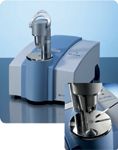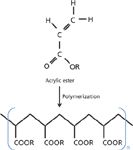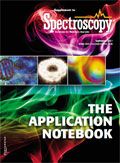Determination of the Degree of Cure of a Varnish
Modern paints and varnishes are complex mixtures and the organization of the material properties is an important task. One of the most essential variables is the curing which should in most cases take place in a reasonably short time span that can range from a fraction of a second to many days. It is difficult to evaluate the degree of curing and its completeness by visual inspection.
Modern paints and varnishes are complex mixtures and the organization of the material properties is an important task. One of the most essential variables is the curing which should in most cases take place in a reasonably short time span that can range from a fraction of a second to many days. It is difficult to evaluate the degree of curing and its completeness by visual inspection. Therefore, an unbiased and reliable quantitative analysis is needed in quality control but also in R&D to optimize the varnish or the curing method respectively.
FT-IR spectroscopy is a quick and reliable method to measure the degree of cure of paints, varnishes and the like. High quality IR spectra can be recorded in a few seconds; usually there is no need for sample preparation or costs for expensive consumables. Within only a minute FT-IR spectroscopy allows drawing a quantitative conclusion about the curing state of the sample.
Instrumentation
The measurements shown in this application note were performed using the very compact ALPHA FT-IR spectrometer equipped with the robust and sensitive Platinum-diamond ATR-module. Long life components, extremely user-friendly maintenance and the ALPHA's low energy consumption result in incomparably small running costs. Due to the unique design, the ALPHA is rugged and insensitive to external disturbances like e.g. impacts and vibrations. Therefore, the instrument can be moved safely and, with a weight of only 7 kg and its compact dimensions, also very easily.

Figure 1: ALPHA-P with diamond ATR.
Today most routine measurements are mainly performed with the attenuated total reflection (ATR) technique, as this is much more comfortable to use than the conventional transmission mode. Hereby the IR radiation penetrates slightly (a few microns) into the sample surface. The IR detector of the FT-IR spectrometer can then measure the absorbance resulting from the sample. All types of samples (e.g. solids, liquids, powders, pastes, pellets, slurries, fibers, etc.) are just put on the accessory before the data acquisition is performed. The full analysis takes less than a minute, including sampling, measurement and data evaluation.
The ideal accessory for the measurement is the Platinum diamond ATR-module which is extremely robust and very easy to operate. Its ergonomic one-finger clamp mechanism allows an extremely easy sampling of solid samples. To provide the user an unobstructed access to the sampling area, the pressure applicator can be rotated by 360°. Diamond is a very hard-wearing, chemically inert and therefore ideal material for the analysis of a wide range of samples.
Example Applications
In our example application we want to show the analysis of an acrylic varnish that builds up a protective cover after being cured with UV light. The basic chemical reaction is described in Figure 2; the reaction process is a radical polymerization where an acrylic ester is polymerized by the opening of a C=C double bond.

Figure 2: Basic reaction scheme of an acrylic varnish.
As a reference two samples are available, one that has not been exposed to UV light (0% cure) and one that has been exposed with an excess of UV light (100% cure). The spectra were measured with the Platinum diamond ATR in the range of 4000–400 cm-1 with a resolution of 4 cm-1 and with 24 scans each resulting in a measurement time of about 25 s/spectrum. At first glance the spectra look very similar as can be seen in the spectra of the cured and uncured varnish samples look very similar (Figure 3).

Figure 3: FT-IR spectra of the acrylic varnish, uncured (blue) and 100% cured (red).
Taking a closer look into the fingerprint region, it is obvious that there are many characteristic differences. Many bands from the C=C double-bonds are reduced upon curing, a direct consequence from the polymerization reaction where double-bonds are transformed into single-bonds. This effect is for instance clearly visible at the bands located at 1407 cm-1 (resulting from the C=C–H in plane deformation vibration) and 810 cm-1 (resulting from the C=C–H out of plane deformation vibration) that are both almost absent after the polymerization reaction. Figure 4 shows a magnification of the region around 1410 cm-1 with the bands of the two reference spectra and an additional band from a spectrum with an unknown curing degree. Using the reference spectra a simple two point calibration can be set-up based on the intensity of the band at 1410 cm-1. By applying the calibration on the spectrum of the unknown sample it is possible to determine the degree of cure of the unknown sample to 88%.

Figure 4: FT-IR spectra of the acrylic varnish, uncured (blue) and 100% cured (red). The magenta colored spectrum results from the unknown sample.
Summary
Bruker Optics FT-IR-spectrometer ALPHA with a diamond ATR module offers a quick and robust measurement method for the degree of cure of polymeric varnishes. The system allows quantifying the degree of cure by using simple two-point calibrations. As the setup of new calibrations for other varnishes is quick and straightforward, the method is quite suitable to be applied on a wide product portfolio. Moreover the ALPHA system can be used for additional applications like the quality check of incoming goods and analysis of product failures. Due to a robust instrumental setup, simple sample preparation and a user friendly measurement procedure the analysis can even be performed by untrained users.
Bruker Optics, Inc.
19 Fortune Drive, Billerica, MA 01821
tel. (978) 439-9899 ext. 5110
Website: www.brukeroptics.com
